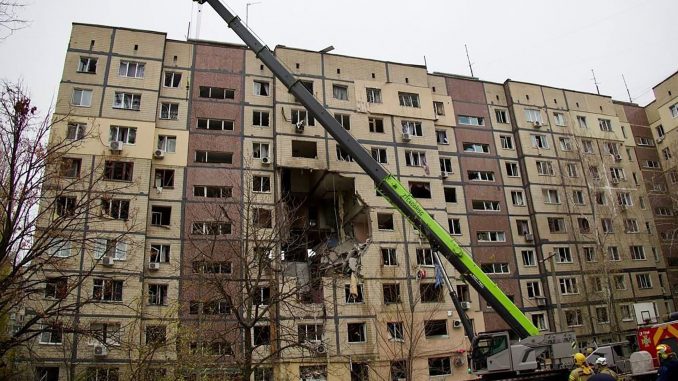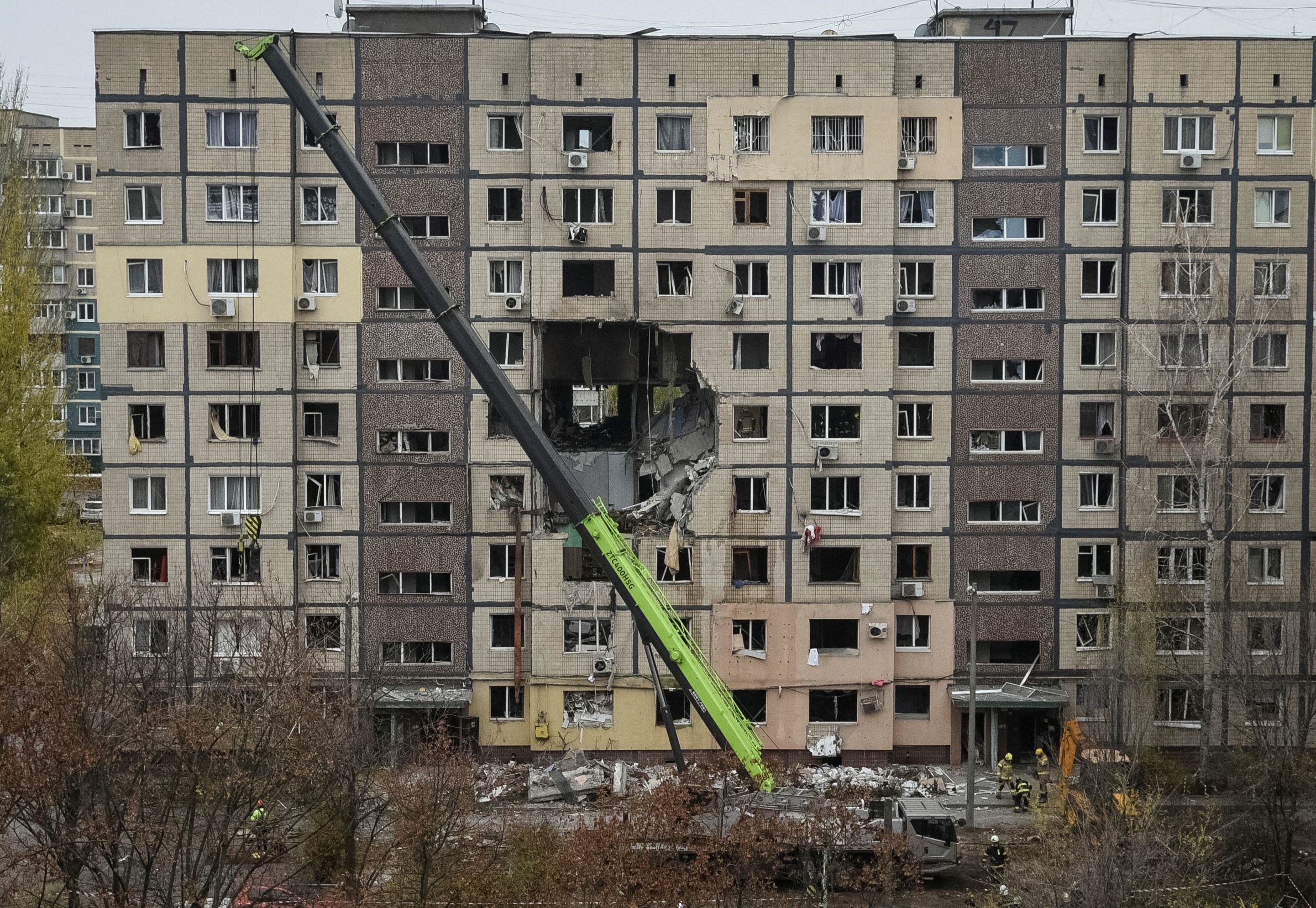
civil infrastructure was hit by Russian missile and drone attacks, in Kyiv, Ukraine, November 8, 2025 [Gleb Garanich/Reuters]
Published November 8, 2025
Deaths and Injuries Mount After Russian Strikes Hit Ukrainian Homes and Energy Sites
In the early hours of 8 November 2025, Ukraine was rocked by one of the largest waves of attacks since the war began. Over 450 drones and 45 missiles struck civilian homes and critical energy infrastructure across multiple regions, leaving a trail of destruction, deaths, and injuries. The scale of the assault has left communities reeling, with families displaced, electricity cut off, and hospitals stretched to their limits.
The Attacks
-
Dnipro: A residential building in the city’s northern district was struck by a drone. Local authorities confirmed that three people were killed and twelve injured, including children. Witnesses described scenes of chaos: neighbors rushed to pull debris away, and children were seen crying amidst shattered windows and damaged walls. “I have never heard anything like it,” said one resident. “The building shook like an earthquake, and the screams… it was terrifying.”
-
Kharkiv and Kyiv regions: Several power plants and substations were hit, leaving thousands of residents without electricity or heating. Blackouts stretched across entire neighborhoods, forcing families to light candles and huddle under blankets in freezing conditions. Hospitals struggled to keep critical systems running, relying on backup generators.
-
Poltava region: Thermal power plants were disabled, triggering rolling blackouts and halting industrial operations. Local businesses reported halted production, and water supply systems faced intermittent disruptions due to the loss of energy.
-
Overall scale: Ukrainian officials reported that 25 different locations across central and eastern Ukraine were targeted, combining residential areas and energy facilities in a coordinated attack.
Human Toll
Beyond the physical destruction, the emotional and social impact is immense:
-
Displacement: Many families were forced to leave their homes, seeking refuge in metro stations, shelters, or with relatives. Children struggled to comprehend the sudden loss of security in their own neighborhoods.
-
Psychological trauma: Repeated air alerts and the sound of explosions have left communities on edge. In one shelter in Dnipro, parents reported that children refuse to sleep alone and constantly ask if it is “safe to go outside.”
-
Healthcare strain: Hospitals reported a surge in patients with injuries ranging from broken bones to burns and shrapnel wounds. Medical staff worked around the clock amid limited electricity, often improvising to treat patients in challenging conditions.
Community Response
Even amid the devastation, acts of resilience and solidarity have emerged:
-
Volunteers and local rescue teams raced to clear debris and assist victims.
-
Neighborhoods organized temporary shelters, food distribution, and warmth centers for those without electricity.
-
Authorities worked to restore emergency power lines and heating in key areas, although full recovery is expected to take days or even weeks in some regions.
Residents in Kyiv, Kharkiv, and Dnipro described a mixture of fear and determination. “We are scared, yes,” said one mother in Kyiv. “But we help each other. That’s the only way to survive these nights.”
On the Ground
The attacks have highlighted the vulnerability of ordinary civilians in modern conflict. Families are living under constant threat, relying on community support and emergency services to navigate daily life. The destruction of energy infrastructure has compounded the crisis, leaving hospitals, schools, and homes in darkness while the cold winter approaches.
Local authorities have issued urgent appeals for calm, caution, and cooperation, emphasizing the importance of following safety protocols during air alerts and power disruptions. Despite the physical and psychological toll, the spirit of resilience remains palpable in the affected regions, with volunteers, neighbors, and first responders working tirelessly to stabilize the situation.



Residential buildings during a power blackout after critical civil infrastructure was hit by Russian missile and drone attacks, in Kyiv, Ukraine, November 8, 2025 [Gleb Garanich/Reuters]
 Implications and Implications Map of the recent Russian strikes on Ukrainian residential and energy sites:
Implications and Implications Map of the recent Russian strikes on Ukrainian residential and energy sites:
1. Humanitarian Implications
-
Civilian casualties: The strikes directly caused deaths and injuries, including among children. This adds to the growing toll of civilians caught in the conflict.
-
Displacement and trauma: Bombed homes force families into shelters or temporary accommodation, creating psychological stress, especially for children and the elderly.
-
Winter vulnerability: Damage to energy infrastructure just before winter leaves millions at risk of cold exposure, lack of heating, and water shortages.
Humanitarian Impact (Red Zones)
-
Dnipro, Kyiv, Kharkiv, Poltava
-
Deaths & injuries: Children and adults affected; emergency medical response activated.
-
Displacement: Families moved to shelters or metro stations.
-
Winter risk: Lack of heating leaves millions vulnerable.
-
2. Energy and Infrastructure Implications
-
Power grid fragility: The attacks on multiple energy sites reveal Ukraine’s power system is highly vulnerable. Blackouts and reduced energy output could last weeks if repairs are delayed.
-
Industrial slowdown: Factories and essential services dependent on electricity and heat may halt operations, further affecting the economy.
-
Long-term reconstruction costs: Repairing destroyed power plants, substations, and residential areas requires billions of dollars and months of work.
Energy & Infrastructure Impact (Yellow Zones)
-
Kyiv region & Kharkiv region:
-
Power plants and substations damaged → rolling blackouts.
-
Industrial operations slowed or halted.
-
-
Poltava region:
-
Thermal plants offline → critical grid instability.
-
-
Central Ukraine:
-
Water and heating networks disrupted → pre-winter crisis.
-
3. Military and Strategic Implications
-
Psychological warfare: Targeting civilians and infrastructure aims to lower morale and create a sense of helplessness among the population.
-
Shift in conflict focus: The strikes signal that the war is not limited to front-line battles but increasingly targets critical civilian systems.
-
Pressure on Ukrainian defense: The government must divert resources to protect infrastructure and civilians, stretching military and emergency response capabilities.
Military & Strategic Impact (Orange Zones)
-
Nationwide threat:
-
Civilian-targeted strikes create psychological pressure.
-
Forces Ukraine to divert resources to defend infrastructure.
-
-
Eastern frontline areas (Donetsk, Luhansk):
-
Increased tension between combat zones and infrastructure attacks.
-
4. Political and Diplomatic Implications
-
International condemnation: Strikes on civilian targets violate international humanitarian law, increasing pressure on Russia from governments and international organizations.
-
Calls for sanctions: The attacks may lead to new sanctions on Russia, particularly in sectors linked to energy or defense.
-
Negotiation leverage: Such attacks could affect Ukraine’s negotiating position by demonstrating vulnerability, but also galvanize Western support for more aid and defensive weapons.
Political & Diplomatic Impact (Purple Zones)
-
International awareness:
-
Potential for additional sanctions on Russia.
-
Increased diplomatic pressure and humanitarian aid requests.
-
-
Ukraine & Allies:
-
Calls for advanced air-defense systems.
-
Coordination on protecting civilian infrastructure.
-
5. Economic Implications
-
Energy supply disruptions: Blackouts affect businesses, schools, hospitals, and transport, with economic losses mounting daily.
-
Inflation risk: Damaged infrastructure can drive energy prices higher domestically and regionally, affecting the cost of goods and services.
-
Investment uncertainty: Continued strikes deter foreign investment and reconstruction funding due to instability and risk to infrastructure.
Economic Impact (Blue Zones)
-
Industrial centers:
-
Production slowdown → economic loss.
-
Local markets impacted due to power outages.
-
-
National level:
-
Energy price surge → inflationary pressure.
-
Increased reconstruction costs → long-term economic strain.
-
6. Regional and Global Implications
-
Energy markets: Attacks on Ukraine’s energy system can ripple through European electricity and gas markets, especially as winter approaches.
-
Security recalibration: Neighboring countries may accelerate their own civil defense and energy security measures to avoid similar vulnerabilities.
-
Humanitarian aid pressures: International agencies may face increased demand for food, fuel, and medical assistance to cope with the civilian impact.
 Overall Takeaway:
Overall Takeaway:
The recent Russian strikes on Ukrainian residential areas and energy infrastructure underscore the evolving nature of the conflict. No longer confined to the front lines, the war now targets the very lifelines of civilian life—homes, power plants, and heating systems—compounding human suffering and economic strain.
The human cost is immediate: lives lost, families displaced, and communities left in darkness just as winter approaches. Strategically, the attacks reveal a calculated attempt to undermine morale, stretch Ukrainian defenses, and demonstrate vulnerability in critical infrastructure. Economically, the repercussions ripple through local industries, energy markets, and the broader national economy, while politically, the strikes intensify calls for international sanctions and support.
Yet amid destruction, resilience persists. Ukrainian authorities, emergency teams, and civilians are working tirelessly to restore power, aid victims, and maintain social stability. The international community watches closely, with the attacks serving as a stark reminder that the protection of civilians and critical infrastructure is central to any long-term resolution.
In essence, these strikes are not just tactical moves—they are tests of endurance, governance, and humanity. How Ukraine and the world respond will shape not only the immediate trajectory of the war but the broader principles of civilian protection in modern conflict.
SOURCES: REUTERS – Russia attacks Ukraine energy facilities, kills three people
AL JAZEERA – Deaths, injuries after Russia hits residential and energy sites in Ukraine





Be the first to comment